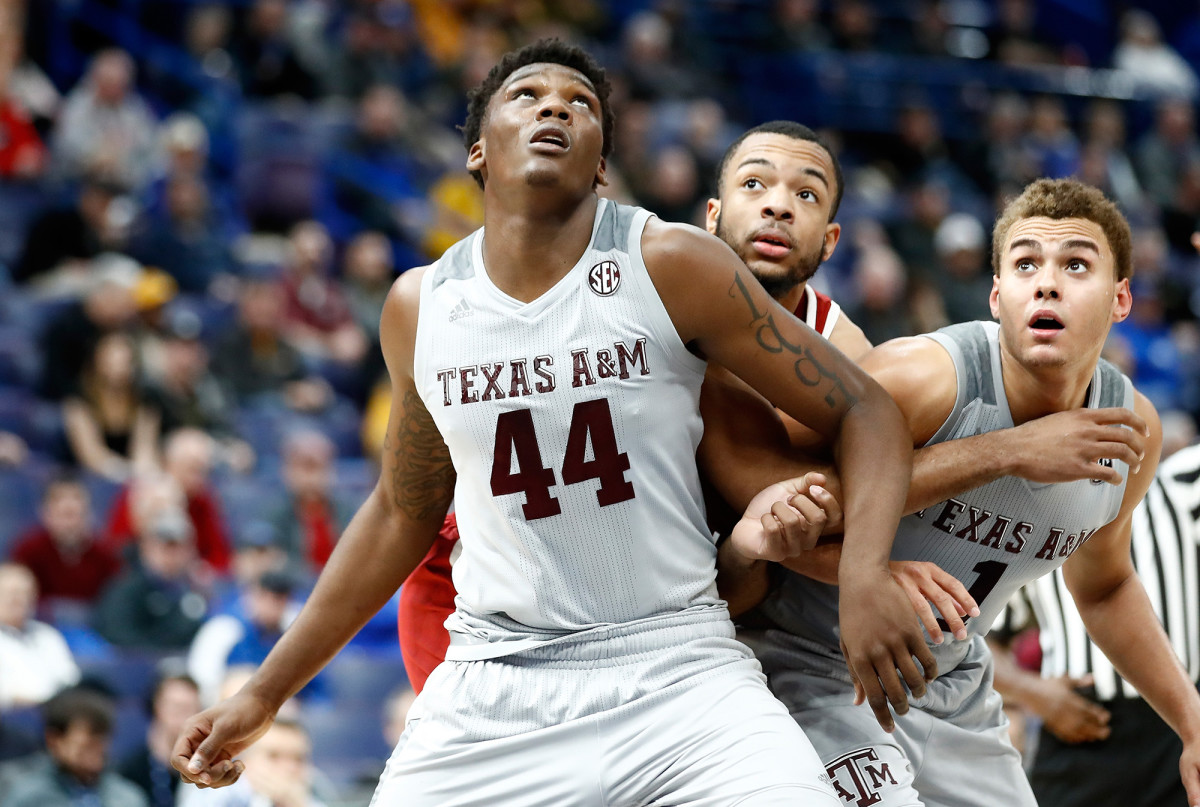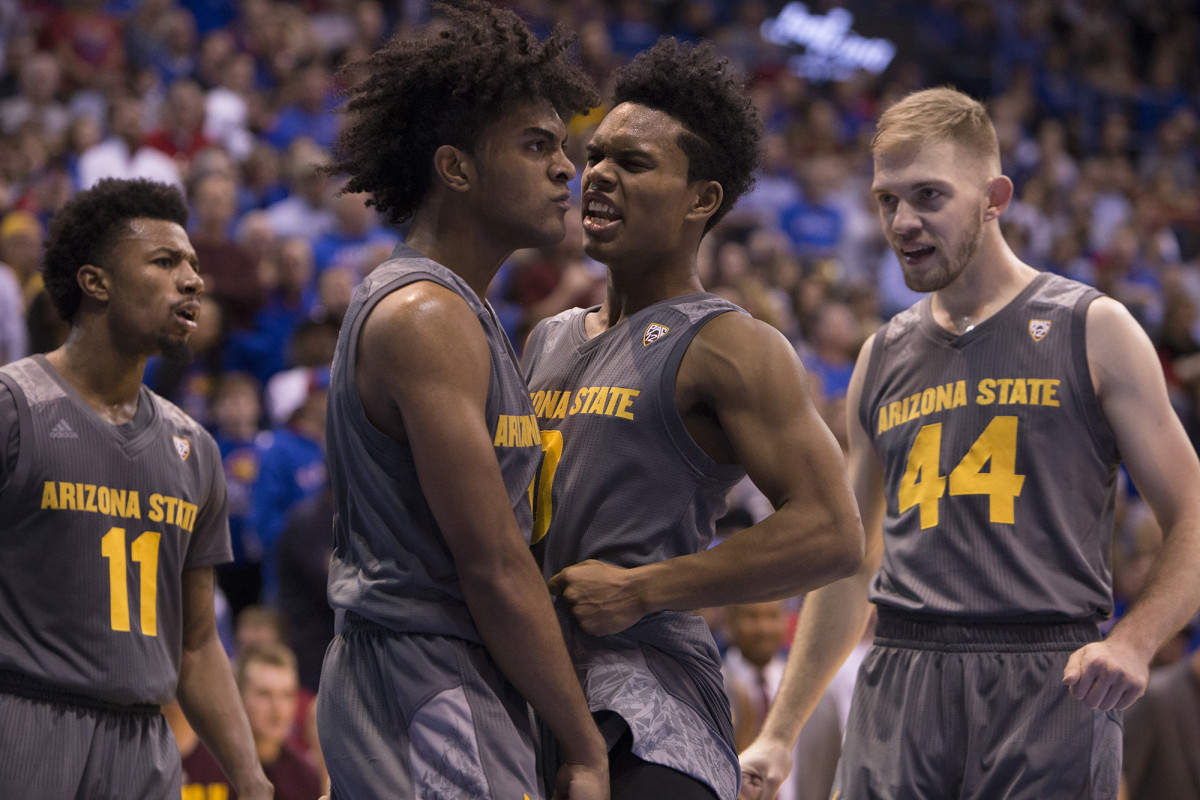‘Gray Became the New Black’: How College Basketball Jerseys Went Platinum

Texas Tech’s basketball court is objectively busy. A darker hardwood shades both lanes and a watermark of the Lone Star State, which rests under the school’s massive, red and black logo in the center of the court. On the perimeter, a cherry-red color borders the end lines. When you plop in Baylor’s audacious, highlighter-yellow uniforms, your eyes begin to fatigue. Add in Texas Tech’s new, gray alternates and the Dec. 29 contest was…colorful.
The Red Raiders’ distinct jerseys are part of the team’s new uniform set for the 2017-18 season, which Coach Chris Beard and Under Armour collaborated to create. “We were holding the grays back for the right moment, and after getting some feedback from the guys, our Big 12 home opener was the perfect time to debut them,” said Collin Prentiss, Texas Tech’s assistant equipment manager. The new gear worked. Texas Tech waxed No. 18 Baylor 77-53, the beginning of a second-place regular season in the Big 12 and a No. 3-seed in the NCAA tournament, where the Red Raiders are now into the Sweet 16.

Under Armor easily manufactured the grey uniforms. They’ve generated gray alternates for Boston College, Northwestern, St. John’s, Utah and South Carolina among several others. Gray uniforms—from each of UA, Nike and Adidas—have permeated the college basketball world as prolifically as brackets flood offices every March. “A uniform isn’t just a uniform anymore,” said Adam Clement, Under Armor’s senior design director. “It’s also a fashion statement.” For the better part of this century, college basketball programs have turned hardwoods across the country into runways. “They were focused on recruiting and trying to bring interest,” said Michael Smith, Nike Basketball’s product director for uniforms. “That’s kind of where the black trend started.”
Your favorite team likely debuted a jet-black alternate jersey in the early 2000s. Apparel companies saw sable uniforms made teams appear fiercer, faster and presented “a unique way to have an edgy-looking uniform,” Smith said. A mercenary of the League of Shadows induces more fear than an ivory-robed Tai Chi master. “Even teams that didn’t have black in its color palette were wearing black uniforms,” said Adam Clement, Under Armour’s senior design director. “And that sort of ran its course.”
In the years after David Stern instituted the NBA dress code in 2005, many teams such as Kentucky, Washington State and Texas—schools clearly devoid of black in their traditional color schemes—began receiving pushback about the alternate sets. “There were a lot of opinions around the NCAA space that black was ‘too polarizing,’” Smith said. “Not necessarily the athletic directors, but a lot of the university presidents and administration started to make some noise about, ‘That’s not our team color, we don’t want to see black.’”
The move away from black as an alternate jersey has college basketball’s jersey reset in full swing. The largest inflection point came in 2012, when Nike debuted a special Hyper Elite Platinum jersey for nine prestigious programs across the country. The company sought to highlight programs that had claimed championships wearing Nike head to toe, schools such as Syracuse, Duke, Florida and Arizona, that didn’t have a trace of gray or silver in their logos. The one-off uniforms received rave reviews.

“We used some pretty reflective silvers in that uniform and some hyperized team colors,” Smith said. Which led Nike to spin off those metallic materials into their schools that already boasted a semblance of gray in their official logos, such as UConn and Georgetown. More positive feedback returned, and Nike began dressing colleges across the country in gray, again featuring many schools harboring signature colors not even remotely close to the tone. “It was a very popular and safe place for teams to have an alternate—and in some cases, a fourth—uniform that kept it unique and fresh for their players, but was not nearly as polarizing for school administrators,” Smith said. “Gray was more in the safe zone, like white is.”
Under Armour heard the same response from its schools. “Varying shades of gray sort of became the new black,” said Clement. “It offers something completely different. Gray was neutral enough where it closed those gaps.” Not only have gray uniforms provided a widespread option for schools to don another alternate jersey, but the more innocuous color also provides greater functionality within the NCAA and many conferences’ uniform restrictions.
According to the NCAA bylaws, home teams are required to wear a lighter color jersey than their visiting opponent. However, two schools can mutually consent to that rule being modified before a game. Many conferences have a strict guideline on when this agreement must be reached, as well. The SEC, for example, instructs teams must agree at least five days in advance of a contest in order for a home team to wear a darker color than their rival, which has actually sparked some gamesmanship among conference rivals.
“Gray allows you to have a home alternate. It doesn’t affect the visitors and it’s not flashy,” said Peter Warden, Texas A&M’s longtime coordinator with Adidas, the school’s apparel partner. Adidas did not offer comment for this story. This season, the Aggies first wore a gray uniform with maroon trim and lettering during the 2016 NCAA Tournament. Adidas presented the school with the option, Texas A&M’s players relished the look and the Aggies reached the Sweet 16. This season, the team has included a “gray ice” uniform in its regular rotation, an Adidas creation that has been in the works since June 2016. The jersey features a light gray base, darker, silvery gray trim, maroon numbers and lettering and a sleek, silver font for the players’ nameplates on the back. Adidas is frequently brainstorming future designs with their top schools. “There’s a lot of conversation and they’re years ahead,” Warden said.
When Arizona State rebranded its athletic department in 2011, the school introduced a gray anthracite into their uniforms color palette, harkening to the mineral that is so prolifically mined across Arizona. “It ties back into the history of the state,” said Becky Parke, the Arizona State assistant athletic director responsible for overseeing marketing, game experience and special events. The Sun Devils first dressed their football team in an anthracite and copper jersey. This season, the men’s basketball team has showcased their own Adidas-created gray ice anthracite uniform. ASU’s features a dark gray base with gold lettering aside from a light gray nameplate on the back.
Arizona State flashed the new alternates in its momentous upset win at No. 2 Kansas on Dec. 10. Seeing the Sun Devils draped in gray may have startled traditionalists amongst the game’s national television audience, but no college basketball team looks more jarring in silver than Iowa State. The Cyclones introduced a gray uniform for their women’s basketball and football teams two years ago, but the men’s basketball team had been consistent in sticking with the school’s classic cardinal, gold and white colors. Until Mar. 2016, when Iowa State officials met with Nike in a Houston hotel suite during the Final Four to redesign the program’s entire uniform collection.

The jersey reset coincided with Nike’s AeroSwift technology launch for Team USA Basketball’s Rio Olympics uniforms. And in addition to the white, gold and cardinal uniforms, Nike had drafted an extremely dark, metallic gray alternate for Iowa State’s approval. The school waited to announce the jerseys before its home matchup with Northern Illinois on Dec. 4. But the design had already made some rounds. “It’s something that our athletes liked a lot during the recruiting process here, the batch of kids that we’re getting in the 2018 class, we kind of teased it with them and showed them some concepts and artwork,” said Micah Byars, Iowa State’s director of basketball operations. Comprised of Nike’s own anthracite colorway, the uniform features “Cyclones” across the chest, highlighting the only school in the country to claim that mascot. The angular stripes on the sides are intended to represent the whirring of a cyclone’s rotating movement. “We’ve gotten some positive feedback, but again, it’s like anything, some people will tell you it’s an abomination,” Byars said.
Nike does attempt to tie gray or silver uniforms into something representative of the school or region. “The depth of colors in some of these grays, you can look at clouds, the New York City skyline, there’s just a lot of things that have gray in it, that are pretty iconic,” Smith said. Nike’s gray uniform for the Tennessee Volunteers references the tonal layers of the Smoky Mountains, one of the state of Tennessee’s most emblematic landmarks.
When Houston redesigned its jerseys for this season, the Cougars originally mulled introducing a camouflage alternate or a throwback to the Phi Slamma Jamma era, when Hakeem Olajuwon and Clyde Drexler led the program to three straight Final Fours from 1982-84. “It was an opportunity to bring another one into the mix,” said Lauren Sampson, the Cougars’ director of external operations. Graduate Assistant Mikael McLean suggested bringing back a lighter gray jersey that the Cougars wore in the early 2010s when he played under James Dickey. This season, Houston’s senior captains, led fittingly by star guard Rob Gray, chose the team’s color for each contest. They opted for the new gray uniforms when the Cougars ended No. 5 Cincinnati’s 16-game winning streak on Feb. 15. Perhaps Houston should've worn gray against Michigan. “The uniform wars,” said Sampson, who actually styled Gray’s man bun prior to games. “You need to keep things constantly fresh.”
Under Armour has felt that pressure. “All the manufacturers, we’re all trying to stay ahead of things and do the next greatest thing,” Clement said. When Texas Tech inquired about an additional uniform option, UA presented a wide swath of different grays to choose from, ranging from what they deem “graphite”, a medium, neutral gray tone, to their own version of “anthracite,” the darkest a team can get without wearing black. “We can get pretty creative with our names at times,” Clement chuckled. Ingenuity will now forever be a part of the college athletics apparel game. You’ll be hard pressed to find a Power Five football program that doesn’t offer multiple helmets in addition to five or six jersey and pant options. Gray and silver are having their moment, yet merely swept across basketball in the wake of black’s dominance in the 2000s. “It’s always just about finding what’s next,” Smith, Nike’s uniform lead, said. “What’s going to be the future?”
